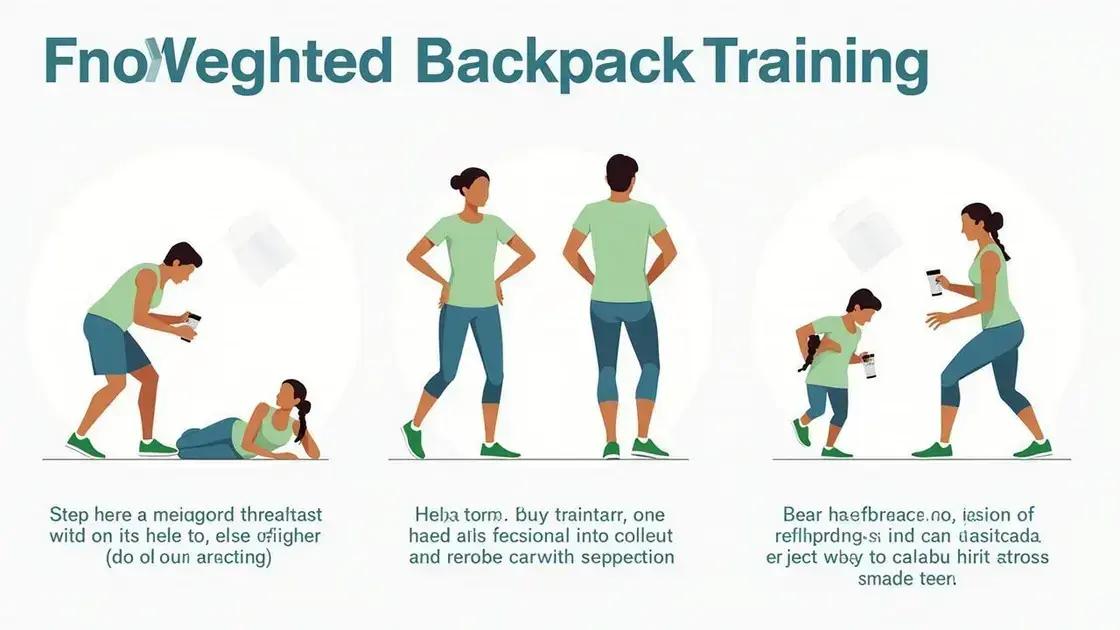Using a weighted backpack for resistance training effectively enhances your workouts by increasing muscle strength, improving endurance, and boosting your metabolic rate. Start with a lightweight backpack, incorporate suitable exercises like squats and lunges, and prioritize safety with proper form, hydration, and gradual weight increase to avoid injuries.
Are you looking to boost your strength training routine? How to use a weighted backpack for resistance training is an effective and versatile way to increase the intensity of your workouts. This method allows you to add extra weight without the need for expensive gym equipment. In this article, we will delve into the best practices, benefits, and safety tips to maximize your training.
Understanding Weighted Backpacks

Understanding weighted backpacks is essential for anyone looking to enhance their fitness routines. A weighted backpack is simply a backpack filled with weights, such as dumbbells, plates, or even manual weights. These backpacks are designed to distribute weight evenly across your back, which is crucial for performance and safety.
How Weighted Backpacks Work
The concept behind using a weighted backpack is straightforward: by adding extra weight to your body, you increase the resistance during physical activities. This training technique can effectively intensify various exercises like jogging, hiking, or bodyweight workouts, pushing your muscles to work harder and gain strength.
Choosing the Right Backpack
When looking for a weighted backpack, ensure it is sturdy and comfortable. Look for adjustable straps and breathable fabric to enhance comfort during workouts. The weight you choose should be manageable; beginners might start with 5-10% of their body weight and progressively increase as their strength improves.
Weight Distribution and Balance
Proper weight distribution is key when using a weighted backpack. Place the weights close to your back and evenly across the backpack to maintain balance. This helps prevent strain on your body and makes the workout more effective. Remember, the aim is to challenge yourself, not to compromise your safety.
By understanding weighted backpacks, you can tailor your workouts to not only achieve strength gains but also improve stamina and endurance. This simple yet effective training tool can be integrated into various exercise routines, making it a versatile addition to your fitness arsenal.
Benefits of Resistance Training

Benefits of resistance training are numerous and significant for overall health and fitness. This form of exercise involves using resistance to build muscle strength, improve endurance, and enhance overall fitness. Here are some key benefits:
Increased Muscle Strength
Resistance training leads to increased muscle strength. When muscles are subjected to resistance, they adapt by becoming stronger. This is crucial for daily activities, sports, and injury prevention.
Improved Bone Density
Engaging in resistance training helps increase bone density. Stronger bones are less susceptible to fractures and diseases like osteoporosis. Regular resistance workouts can be an effective way to maintain bone health as you age.
Enhanced Metabolic Rate
Another great benefit of resistance training is an enhanced metabolic rate. Muscle tissue burns more calories at rest compared to fat tissue. This means that by building muscle through resistance training, you can increase the number of calories your body burns when not exercising.
Better Flexibility and Balance
Resistance training can also improve flexibility and balance. By working through a full range of motion during exercises, you can increase your flexibility over time. Improved balance can help reduce the risk of falls, especially for older adults.
With so many benefits, incorporating resistance training into your fitness routine can be highly advantageous for physical health and overall well-being. It’s effective for all age groups and can easily be adjusted to personal fitness levels.
How to Start Using a Weighted Backpack

How to start using a weighted backpack involves taking the right steps to ensure safety and effectiveness. Here are some easy guidelines to follow:
Choose the Right Backpack and Weight
Select a backpack that is durable and has adjustable straps for comfort. Start with lighter weights, such as 5-10% of your body weight. You can gradually add more weight as you become stronger and more comfortable.
Begin with Basic Exercises
Once you have your backpack ready, start with basic exercises that you are familiar with, such as squats, lunges, or walking. Ensure that the weight does not compromise your form. For beginners, walking is a great exercise to enhance strength while using a weighted backpack.
Incorporate Different Movements
As you gain confidence, incorporate various movements into your workouts. You can try push-ups, burpees, or hiking with the weighted backpack. This variety keeps the workout interesting and engages different muscle groups.
Listen to Your Body
It’s essential to listen to your body and avoid overdoing it. If you feel any discomfort or pain, reduce the weight or the intensity of your workouts. Proper recovery is just as important as exercise.
By following these steps, you can effectively start using a weighted backpack in your resistance training routine. This approach will help you build strength safely while maximizing the benefits of your workouts.
Safety Tips for Weighted Backpack Training

Safety tips for weighted backpack training are crucial to ensure that your workouts are effective and injury-free. Here are some important safety guidelines to follow:
Start Slow and Progress Gradually
When incorporating a weighted backpack into your training, begin with light weights. This allows your body to adapt to the added resistance. Gradually increase the weight by small increments as you gain strength and confidence.
Check Your Form
Proper form is essential when exercising with a weighted backpack. Ensure your posture is correct to avoid strain on your back and joints. Pay attention to your body mechanics, keeping your core engaged and your back straight during movements.
Stay Hydrated
Staying hydrated is essential, especially when adding extra weight to your workouts. Drink plenty of water before, during, and after your training sessions. Hydration helps maintain energy levels and prevents cramps.
Choose Suitable Exercises
Select exercises that are appropriate for your fitness level and experience. Avoid high-impact movements that could lead to injury when using a weighted backpack. Consider starting with low-impact exercises like walking or bodyweight squats.
By following these safety tips for weighted backpack training, you can enjoy a successful and safe resistance training experience. Keeping your safety in mind will help you achieve better results while minimizing risks.
In conclusion, maximizing the benefits of weighted backpack training
Incorporating a weighted backpack into your resistance training routine can be a powerful way to enhance your strength and fitness levels. By understanding how to use a weighted backpack safely, choosing the right exercises, and following safety precautions, you can achieve your fitness goals effectively.
The benefits of resistance training, including increased muscle strength, improved bone density, and enhanced metabolic rate, make it a vital component of any workout regimen. Starting slowly with the right techniques will help you establish a solid foundation for your training.
Remember to listen to your body and prioritize safety to enjoy a sustainable and rewarding fitness journey. Embrace this versatile tool and take meaningful steps towards a healthier and stronger you.
FAQ – Frequently Asked Questions about Using a Weighted Backpack for Resistance Training
What is a weighted backpack?
A weighted backpack is a backpack filled with weights that you wear during exercises to increase resistance and build strength.
How much weight should I start with?
It’s recommended to start with 5-10% of your body weight. Gradually increase the weight as you become more comfortable and stronger.
What exercises can I do with a weighted backpack?
You can perform basic exercises like walking, squats, lunges, push-ups, and other bodyweight movements to enhance your workouts.
Are there any safety tips I should follow?
Yes, always start slow, check your form, stay hydrated, and choose suitable exercises to avoid injury while training.
Can anyone use a weighted backpack for training?
Most people can benefit from using a weighted backpack, but beginners and those with health concerns should consult a doctor or fitness professional before starting.
How often should I train with a weighted backpack?
Aim for 2-3 times a week, allowing your body to recover between workouts. Adjust the frequency based on your fitness level and goals.












